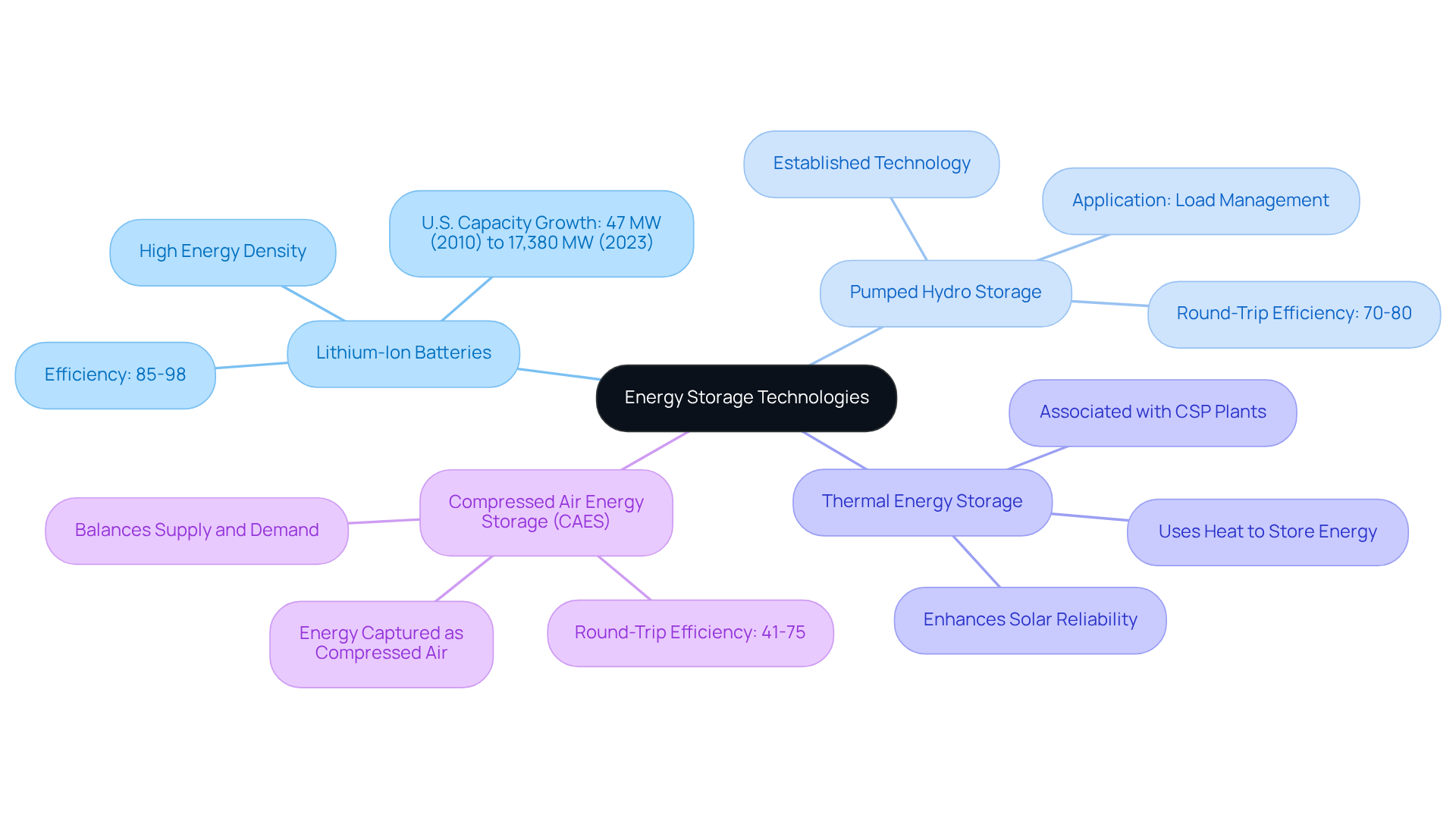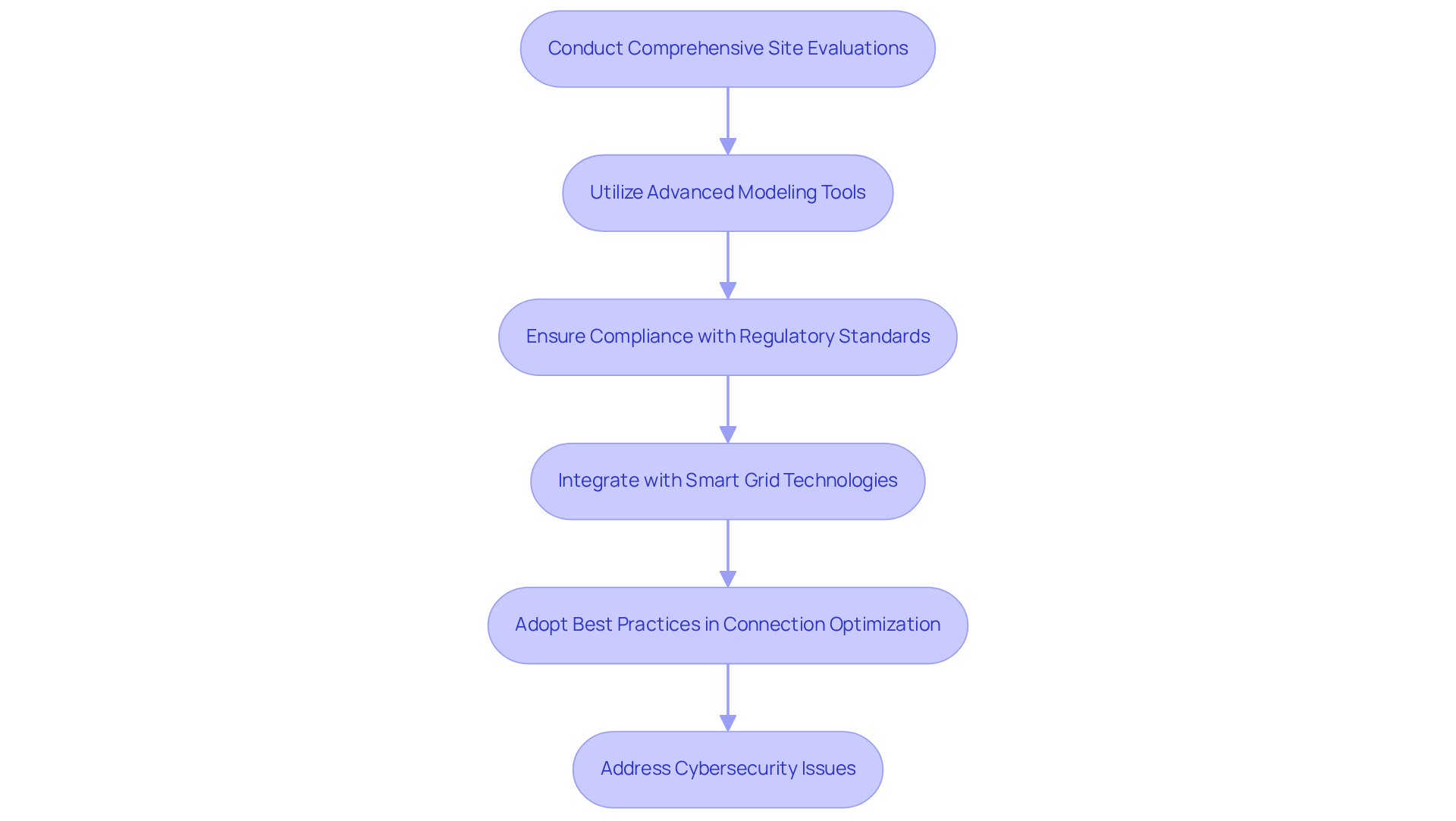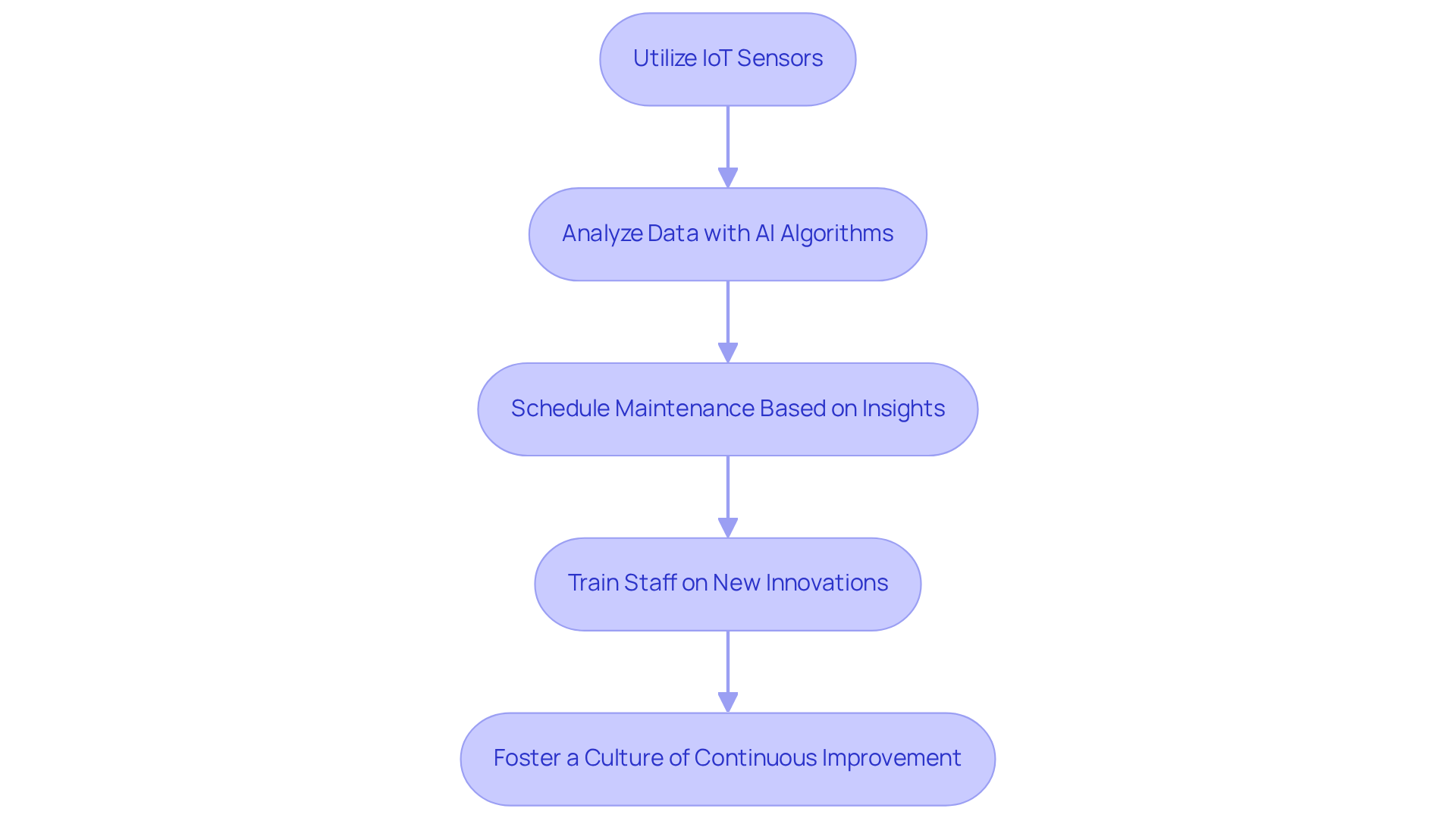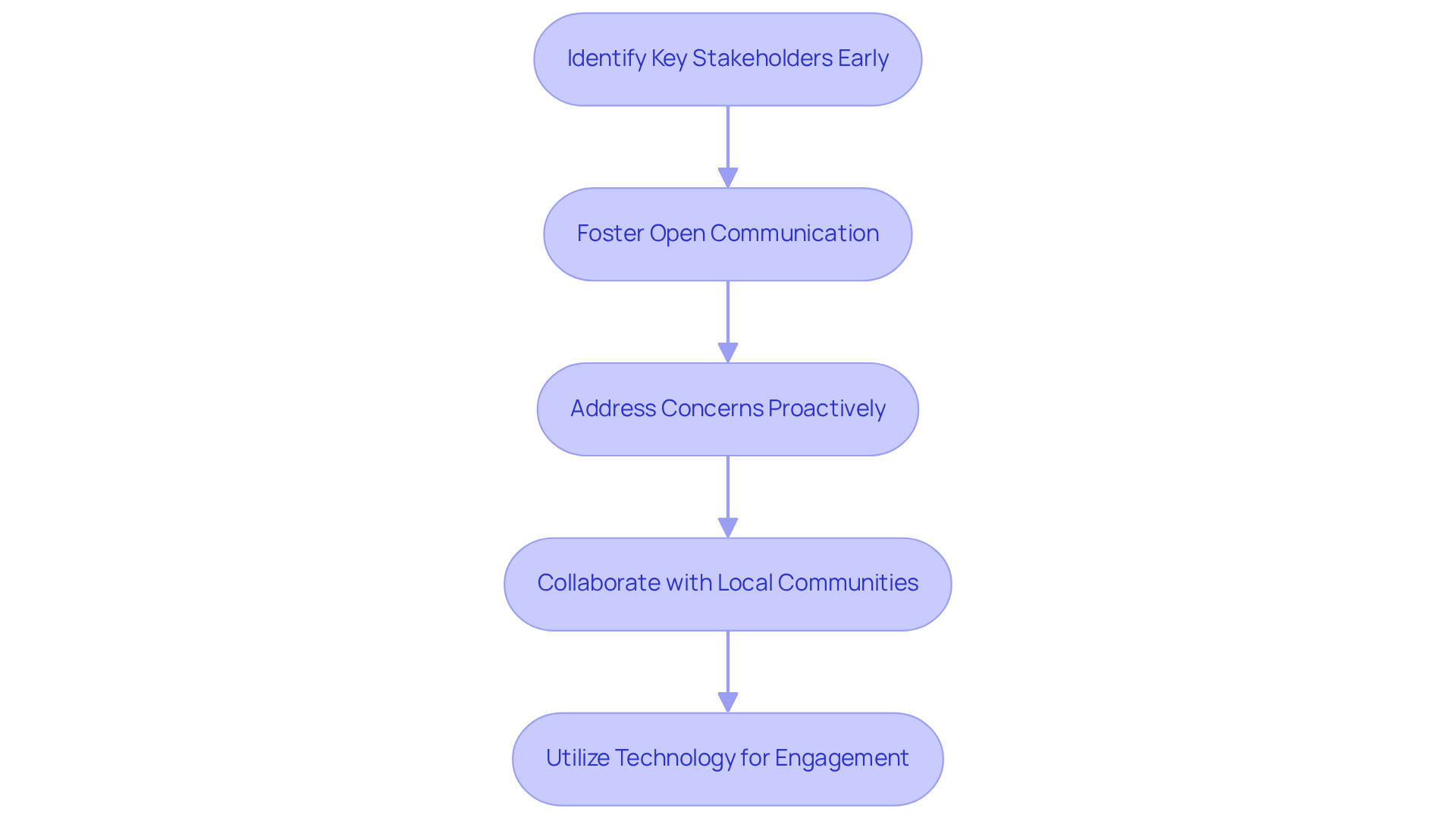Overview
The article presents five robust strategies for optimizing energy storage connections:
- Site evaluations
- Advanced modeling
- Regulatory compliance
- Smart grid integration
- Cybersecurity measures
Each strategy is underpinned by successful implementation examples, emphasizing the necessity of a proactive approach. This includes predictive maintenance and effective stakeholder engagement, both pivotal in enhancing the reliability and efficiency of energy storage systems. By addressing these strategies, we can tackle the complexities of energy storage, ensuring a more resilient and efficient future.
Introduction
In an era where renewable energy sources are increasingly vital, the significance of optimized energy storage connections is paramount. These connections are crucial for integrating renewable resources into the grid, enhancing reliability, and ensuring efficient energy management. This article explores five key strategies that not only optimize energy storage connections but also tackle the challenges faced by stakeholders in this evolving landscape. How can organizations leverage these strategies to navigate the complexities of energy storage and secure a sustainable future?
Understand Energy Storage Technologies and Their Applications
In contemporary power systems, optimized energy storage connections are essential for enabling the integration of renewable resources and enhancing grid dependability. Understanding these innovations, including optimized energy storage connections, is crucial for stakeholders evaluating their suitability for specific applications such as grid stabilization, peak shaving, and load shifting.
Lithium-Ion Batteries are widely recognized for their high energy density and efficiency, making them ideal for applications that require rapid response times. The U.S. battery storage capacity has surged from 47 MW in 2010 to 17,380 MW in 2023, underscoring the growing reliance on lithium-ion batteries in storage applications.
Pumped Hydro Storage is a well-established technique that stores energy by pumping water uphill during periods of low demand and releasing it to generate electricity during peak demand. With a round-trip efficiency of 70-80%, this method proves effective for load management and grid stabilization.
Thermal Energy Storage employs heat to retain energy, often in conjunction with solar power systems. This innovation allows for electricity generation even when solar output is low, thereby enhancing the reliability of solar energy.
Compressed Air Energy Storage (CAES) captures energy in the form of compressed air, which can be released to generate electricity as needed. This method is particularly beneficial for balancing supply and demand in renewable energy systems.
Successful implementations, such as Eco Stor's connection of the largest Battery Energy Storage System (BESS) in Germany to the grid, illustrate the capabilities and market potential of optimized energy storage connections. However, potential challenges must be acknowledged, including the risk of declining U.S. power capacity installations should tax credits be revoked. Industry leaders like Tim Buckley and Debmalya Sen emphasize the importance of these technologies in shaping a resilient power landscape.

Implement Best Practices for Energy Storage Connection Optimization
To optimize energy storage connections, it is crucial to implement the following best practices:
- Conduct Comprehensive Site Evaluations: Assess site conditions thoroughly, considering environmental factors and proximity to power demand centers. This evaluation is essential for identifying the most efficient locations for power reserves, ensuring they can effectively meet demand.
- Utilize Advanced Modeling Tools: Implement sophisticated simulation software to forecast performance across various scenarios. These tools aid in recognizing ideal arrangements and operational strategies, thus enhancing the overall effectiveness of power retention solutions.
- Ensure Compliance with Regulatory Standards: Stay informed about local regulations and standards to avoid costly delays and ensure safe operations. Adhering to these guidelines is crucial for the successful implementation of power retention solutions.
- Integrate with Smart Grid Technologies: Leverage smart grid features to enhance communication and control between power reserve systems and the grid. This integration improves responsiveness and efficiency, facilitating better management of resource utilization and demand fluctuations.
- Adopt Best Practices in Connection Optimization: Learn from case studies that showcase successful power reserve connection strategies. These examples offer valuable insights into effective practices and innovative solutions proven successful in real-world applications.
- Address Cybersecurity Issues: As power retention solutions increasingly become digitalized and interconnected, implementing robust cybersecurity measures is essential to protect against potential threats. Ensuring the security of these networks is vital for maintaining reliable and secure power reserve operations.
Integrating these best practices not only enhances the efficiency of optimized energy storage connections but also contributes to the overall resilience and dependability of the infrastructure.

Leverage Predictive Maintenance for Enhanced Reliability
Applying predictive maintenance approaches significantly enhances the reliability of optimized energy storage connections. This shift from reactive to proactive strategies not only mitigates risks but also optimizes performance. Key steps include:
- Utilize IoT Sensors: Deploy sensors to monitor system performance in real-time, collecting critical data on temperature, charge cycles, and other essential parameters. This continuous monitoring enables early detection of potential issues, ensuring optimal operation.
- Analyze Data with AI Algorithms: Leverage machine learning algorithms to analyze historical data and predict potential failures before they occur. By identifying patterns and anomalies, these algorithms facilitate timely interventions, reducing the risk of unexpected breakdowns.
- Schedule Maintenance Based on Insights: Transition from reactive to proactive maintenance schedules informed by predictive analytics. This approach, which utilizes optimized energy storage connections, minimizes unexpected downtime and lowers maintenance costs, ultimately enhancing operational efficiency. For instance, predictive maintenance can reduce maintenance costs by 25-30% and decrease unplanned downtime by up to 50%.
- Train Staff on New Innovations: Equip maintenance personnel with training in the latest predictive maintenance advancements and practices. This guarantees that teams are well-prepared to implement and manage advanced monitoring solutions effectively.
- Foster a Culture of Continuous Improvement: Encourage ongoing evaluation of maintenance practices and technology integration. By consistently evaluating performance and modifying approaches, organizations can optimize the advantages of predictive maintenance, ensuring long-term dependability and effectiveness in power conservation. As Mazi Hosseini observes, "Predictive maintenance presents a solution to these challenges by delivering real-time insights into the health and performance of power reserve units."
Incorporating these strategies not only enhances reliability but also positions organizations to better manage operational costs and improve overall system performance.

Engage Stakeholders Effectively for Successful Land Acquisition
Successful land acquisition for power reserve initiatives hinges on effective stakeholder involvement and the strategic application of advanced services. To enhance project outcomes significantly, consider implementing the following strategies:
- Identify Key Stakeholders Early: Conduct thorough stakeholder mapping to include landowners, local governments, and community groups. Understanding their interests and concerns is essential for project alignment and success.
- Foster Open Communication: Establish transparent communication channels that keep stakeholders informed and engaged throughout the acquisition process. Regular updates and consultations can mitigate misunderstandings and foster trust.
- Address Concerns Proactively: Actively listen to stakeholder concerns and address them promptly. This proactive approach not only builds trust but also reduces potential opposition, facilitating smoother project execution.
- Collaborate with Local Communities: Engage local communities early to ensure that projects resonate with their needs and values. This collaboration fosters goodwill and support, which are crucial for project acceptance.
- Utilize Technology for Engagement: Leverage Harbinger Land's GIS modeling services and land management software to enhance stakeholder outreach and communication. These tools provide comprehensive data on land ownership and environmental constraints, streamlining the acquisition process and ensuring accountability. Additionally, our document imaging solutions enable efficient title research and leasing, further supporting effective decision-making in land acquisition.
By prioritizing these strategies and leveraging Harbinger Land's services, energy storage projects can navigate the complexities of land acquisition, thereby fostering community support and sustainability through optimized energy storage connections.

Conclusion
Optimized energy storage connections represent a pivotal advancement in the integration of renewable resources and the enhancement of grid reliability. Understanding various energy storage technologies and implementing best practices enables stakeholders to significantly enhance their systems' efficiency and resilience, ultimately contributing to a more sustainable energy future.
Key strategies highlighted throughout the article include:
- Comprehensive site evaluations
- The use of advanced modeling tools
- Compliance with regulatory standards
- Integration with smart grid technologies
- The adoption of predictive maintenance
Each of these practices plays a crucial role in optimizing energy storage connections, ensuring that systems are not only effective but also prepared to meet the challenges of a rapidly evolving energy landscape.
As the demand for reliable and efficient energy storage solutions continues to grow, the importance of effectively engaging stakeholders cannot be overstated. By fostering open communication and collaboration, energy projects can gain the support they need to succeed. Embracing these strategies will lead to better project outcomes and pave the way for a more resilient and sustainable energy infrastructure. The future of energy storage is bright, and it is imperative for industry leaders to take action now to harness its full potential.
Frequently Asked Questions
Why are energy storage technologies important in contemporary power systems?
Energy storage technologies are essential for enabling the integration of renewable resources and enhancing grid dependability, allowing for applications such as grid stabilization, peak shaving, and load shifting.
What are the advantages of Lithium-Ion Batteries?
Lithium-Ion Batteries are recognized for their high energy density and efficiency, making them ideal for applications that require rapid response times.
How has U.S. battery storage capacity changed over the years?
The U.S. battery storage capacity has increased significantly from 47 MW in 2010 to 17,380 MW in 2023, indicating a growing reliance on lithium-ion batteries in storage applications.
What is Pumped Hydro Storage and how does it work?
Pumped Hydro Storage is a technique that stores energy by pumping water uphill during low demand periods and releasing it to generate electricity during peak demand, with a round-trip efficiency of 70-80%.
How does Thermal Energy Storage enhance solar energy reliability?
Thermal Energy Storage retains heat to generate electricity, often used with solar power systems, allowing for energy generation even when solar output is low.
What is Compressed Air Energy Storage (CAES) and its benefits?
CAES captures energy in the form of compressed air, which can be released to generate electricity as needed, helping to balance supply and demand in renewable energy systems.
Can you provide an example of a successful energy storage implementation?
An example is Eco Stor's connection of the largest Battery Energy Storage System (BESS) in Germany to the grid, showcasing the capabilities and market potential of optimized energy storage connections.
What challenges might the energy storage industry face?
Potential challenges include the risk of declining U.S. power capacity installations if tax credits are revoked, which could impact the growth of energy storage technologies.
List of Sources
- Understand Energy Storage Technologies and Their Applications
- Clean Energy Storage Facts | ACP (https://cleanpower.org/facts/clean-energy-storage)
- Homepage (https://energy-storage.news)
- 10.2 Key Metrics and Definitions for Energy Storage | EME 812: Utility Solar Power and Concentration (https://e-education.psu.edu/eme812/node/803)
- The Top 10 Quotes on Energy So Far in 2013 (https://greentechmedia.com/articles/read/the-top-10-quotes-on-energy-so-far-in-2013)
- Energy Storage Solutions in 2025: What’s New? - The Battery Show Asia (https://thebatteryshow.asia/energy-storage-solutions-in-2025-whats-new)
- Implement Best Practices for Energy Storage Connection Optimization
- Optimizing Energy Usage with Battery Storage: Best Practices for Commercial and Industrial Facilities - Polarium (https://polarium.com/insights/optimizing-energy-usage-with-battery-storage)
- The Top 10 Quotes on Energy So Far in 2013 (https://greentechmedia.com/articles/read/the-top-10-quotes-on-energy-so-far-in-2013)
- Energy storage - IEA (https://iea.org/energy-system/electricity/grid-scale-storage)
- Leverage Predictive Maintenance for Enhanced Reliability
- Predictive maintenance of medical devices based on years of experience and advanced analytics (https://social-innovation.hitachi/en/case_studies/mri_predictive_maintenance)
- Ultimate guide to predictive maintenance (https://worktrek.com/blog/predictive-maintenance)
- Adopting Predictive Maintenance Practices for Battery Energy Storage System Safety (https://tdworld.com/distributed-energy-resources/energy-storage/article/21233963/adopting-predictive-maintenance-practices-for-battery-energy-storage-system-safety)
- (PDF) Predictive Maintenance Of Energy-Intensive Industrial Equipment Using IoT And Machine Learning Technologies (https://researchgate.net/publication/392597703_Predictive_Maintenance_Of_Energy-Intensive_Industrial_Equipment_Using_IoT_And_Machine_Learning_Technologies)
- Optimizing Energy Storage Systems with Predictive Maintenance - Arshon Inc. Blog (https://arshon.com/blog/optimizing-energy-storage-systems-with-predictive-maintenance)
- Engage Stakeholders Effectively for Successful Land Acquisition
- (PDF) Stakeholder engagement and influence: Strategies for successful energy projects (https://researchgate.net/publication/382514218_Stakeholder_engagement_and_influence_Strategies_for_successful_energy_projects)
- The Importance of Early Engagement in Successful Land Acquisition (https://theusaleaders.com/articles/early-engagement)
- TOP 25 STAKEHOLDER QUOTES (of 56) | A-Z Quotes (https://azquotes.com/quotes/topics/stakeholder.html)




